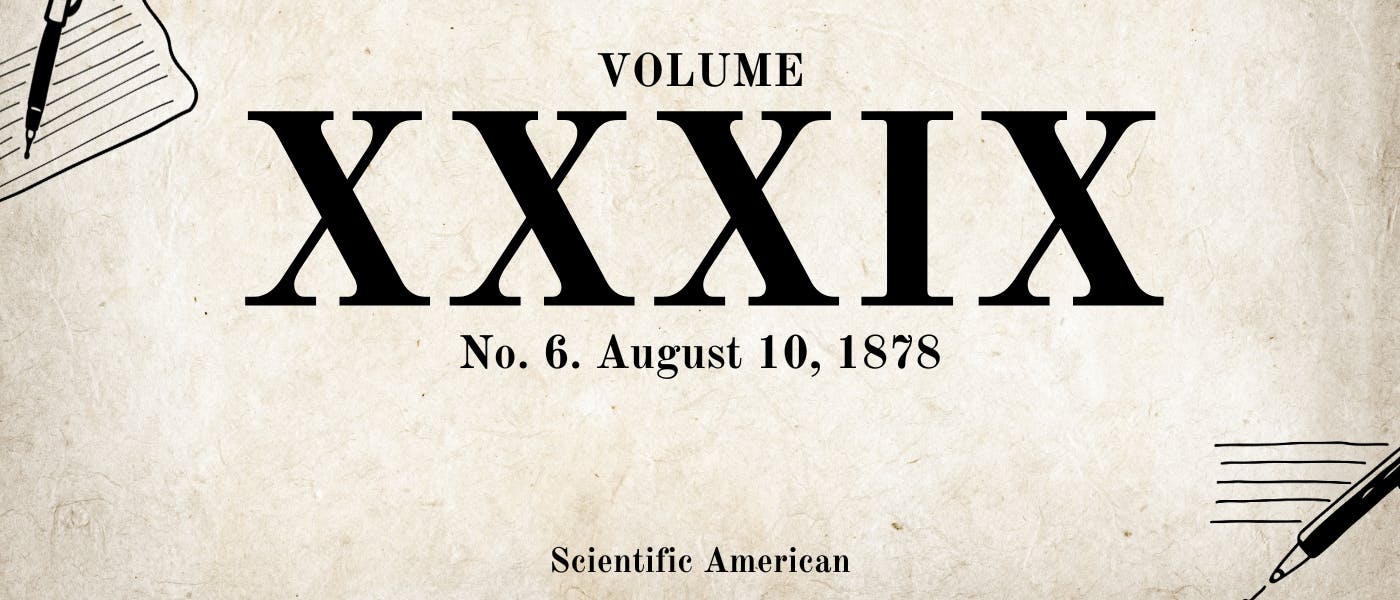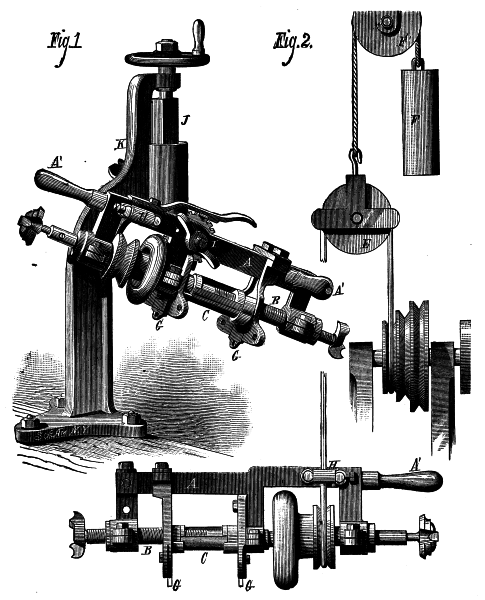Scientific American, Vol. XXXIX. No. 6. [New Series.], August 10, 1878, by Various, is part of the HackerNoon Books Series. You can jump to any chapter in this book here. NEW CUTTING AND BORING ATTACHMENT FOR LATHES.
NEW CUTTING AND BORING ATTACHMENT FOR LATHES.
Our engraving represents a useful little machine which is intended for attachment to lathes. Although it is exceedingly simple it is capable of performing a great variety of work.
The machine is used in two ways, either by attachment to a rigid support, as shown in Fig. 1, or by suspending it by a belt, so that it is capable of universal motion, as shown in Fig. 2.
The supporting frame, A, has three boxes for the spindle, B, and on the shaft at one side of the middle box there are planing knives, C, on the opposite side there is a balance wheel, and a pulley for receiving the driving belt. The spindle, B, extends beyond the ends of the frame, A, and has at each end a socket for receiving interchangeable cutting and boring tools. One end of the spindle is externally threaded to receive a face plate, to which may be attached a disk of wood for receiving sandpaper for smoothing and polishing wood or metal.
The frame, A, is held to its work by means of handles, A', and the spindle is driven by a round belt that passes over a suspended pulley, E, and also over the pulley on the lathe mandrel.
The entire attachment is balanced by a weight, F, attached to a cord that passes over a fixed pulley, F', to the pulley, E, to which it is secured by a swivel hook that permits of turning the belt in any direction. The belt is guided by small pulleys, H, so that the device may be turned without running the belt from the pulley on the spindle.
Guides, G, are attached to the frame, A, for guiding the material being operated upon by the planing knives. The frame, A, may be supported by attachment to an arm, I, at the lower end of the screw-acted follower, J, which slides in a rigid support, K. The arm, I, has a notched disk which is engaged by a spring detent which holds the frame at any desired inclination.
Among the kinds of work that may be done on this machine may be mentioned shaping and edging, fluting and beading table legs, balusters, etc.; dovetailing, boring, carving, paneling, shaping or friezing mouldings, scroll or fret work, inlaying and engraving, blind stile mortising and blind slat planing. By changing the inclination of the spindle different varieties of mouldings may be produced by the same cutter.
The machine may be used as an emery grinder, and it may also be used for drilling and shaping metals. For further information address Mathew Rice, Augusta, Ga.
Decrease of the New York Rainfall.
In his report for 1876, Director Draper, of the New York Meteorological Observatory in Central Park, showed that a careful examination of the records in his office proved that there had been, in late years, a change in the rainfall of New York and its vicinity, affecting seriously its water supply. The decrease had been steady since 1869, previous to which there had been an increase. In his report for 1877, Mr. Draper discusses the question whether the change continues, or is likely to continue, in the same direction, and comes to the conclusion that the rainfall of New York will, most probably, continue to decrease by fluctuations for several years to come; also, that the variations are very nearly the same in the two portions of the year, the division date being July 1.
About HackerNoon Book Series: We bring you the most important technical, scientific, and insightful public domain books.
This book is part of the public domain. Various (2013). Scientific American, Vol. XXXIX. No. 6. [New Series.], August 10, 1878. Urbana, Illinois: Project Gutenberg. Retrieved https://www.gutenberg.org/cache/epub/19406/pg19406-images.html
This eBook is for the use of anyone anywhere at no cost and with almost no restrictions whatsoever. You may copy it, give it away or re-use it under the terms of the Project Gutenberg License included with this eBook or online at www.gutenberg.org, located at https://www.gutenberg.org/policy/license.html


